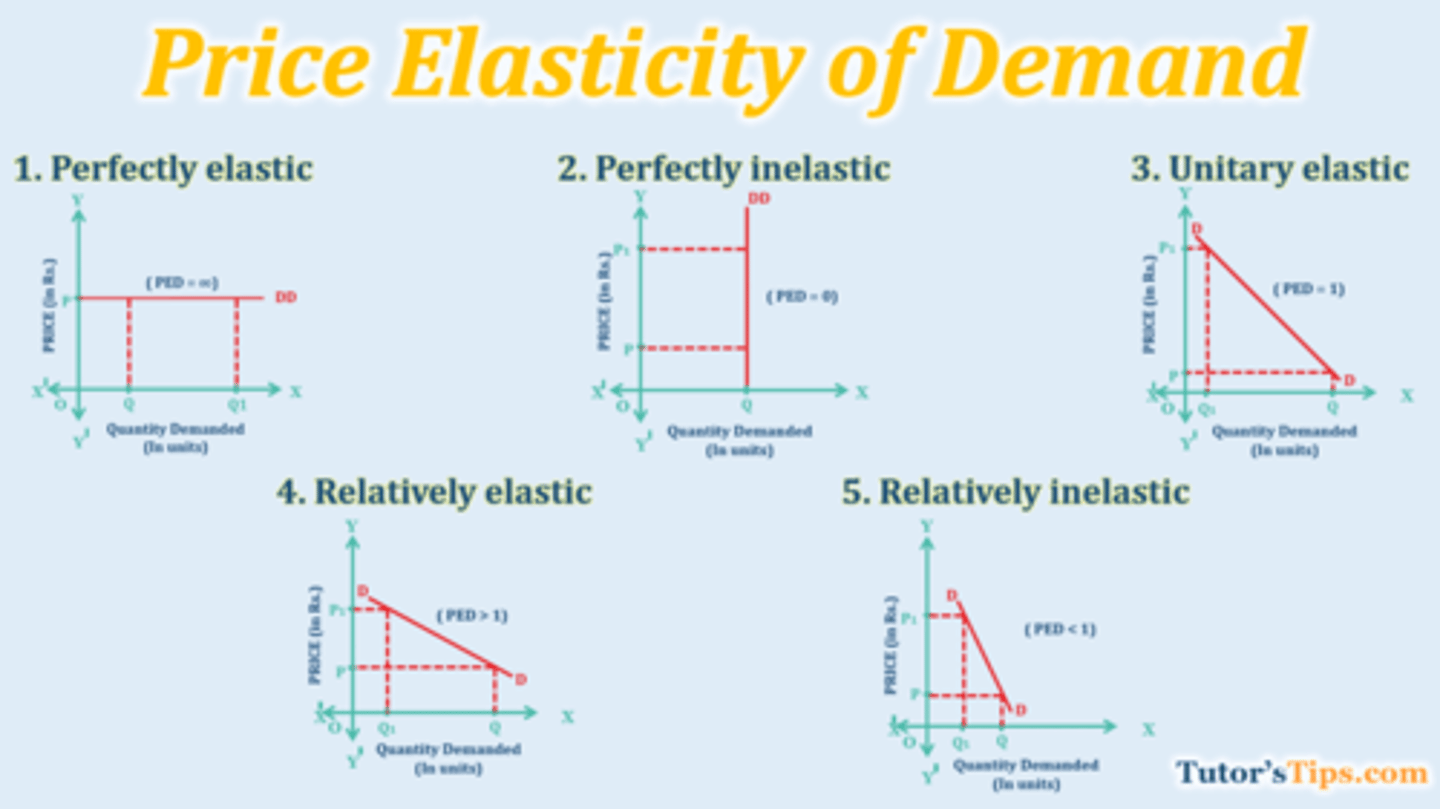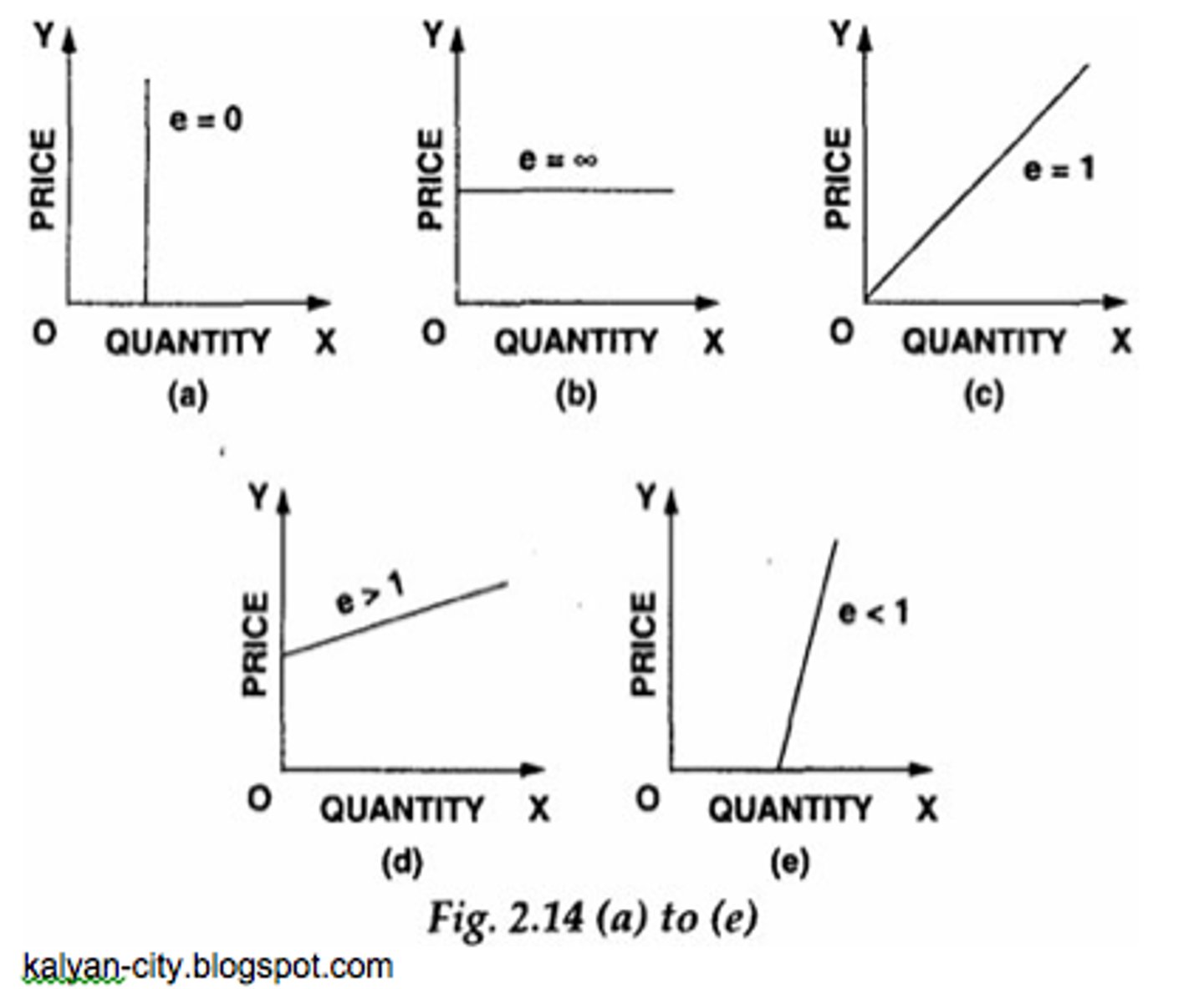IB Economics - 2.5 - 2.6
1/25
There's no tags or description
Looks like no tags are added yet.
Name | Mastery | Learn | Test | Matching | Spaced |
|---|
No study sessions yet.
26 Terms
Price Elasticity of Demand (PED)
A measure of the responsiveness in changes QD to a change in price.
If the QD of a good is highly responsive, demand is said to be price elastic.
If the QD of a good is not very responsive, demand is said to be price inelastic.
PED Formula
% Change in QD / % Change in Price
(negative sign is ignored)
Types of PED
Relatively Inelastic: 0 < PED < 1
Relatively Elastic: 1 < PED < ∞
Unit Elastic: PED = 1
Perfectly Inelastic: PED = 0
Perfectly Elastic: PED = ∞
PED Graphs

How PED varies along the demand curve
Demand is price-elastic at high prices and low quantities, and price-inelastic at low price and large quantities.
At the midpoint, it is unit elastic.
Determinants of PED
- Number and closeness of substitutes: Greater qty of substitutes = More elastic demand
More close substitutes = More elastic demand (e.g. Coke and Pepsi)
- Necessities VS Luxuries:
Necessities = Inelastic Demand
Luxuries = Elastic Demand
- Length of time:
More time = More elastic demand, as consumers have time to think and more firms can enter the market.
- Proportion of income spent on good:
Greater proportion of income = Elastic Demand
Smaller proportion of income = Inelastic Demand
PED and TR
If a product's demand is elastic, the firm can reduce the price to increase TR.
If a product's demand is inelastic, the firm can increase the price to increase TR.
If a product's demand is unitary elastic, the TR will stay the same.
PED and indirect taxes
Lower PED = Higher indirect taxes = Higher Govt Revenue
Revenue and consequences of primary producers
Primary commodity prices are volatile. Farmers cannot rely on them for consistent income
PED and Primary Commodities
Low PED (Inelastic) because goods like food are necessities that have no substitutes. Also small proportion of income.
PED and Manufactured Goods
High PED (Elastic) because goods have lots of substitutes and take up large proportions of income.
Income Elasticity of Demand (YED)
A measure of the responsiveness of demand to changes in income.
YED Formula
% Change in QD / % Change in Income
Normal Good
A good for which the demand increases as income increases and decreases as income falls (e.g. vacations, organic food, technology)
Inferior Good
A good for which the demand decreases as income rises and demand increases as income falls (e.g. second handed books and clothes, public transport)
YED Signs
If YED is -ve: The good is inferior
If YED is +ve: The good is normal
Types of YED
If YED < 1: Necessities, income inelastic demand (demand remains relatively constant regardless of changes in income)
If YED > 1: Luxuries, income elastic demand. (demand changes relatively more when income changes)
Application of YED on the rate of expansion
YED is useful for firms to help them decide what goods to produce and how a change in overall income in the economy (e.g. booms and recessions) affects the demand for their products.
Application of YED for sectors
Incomes are generally rising, but demand for goods produced in the primary sector (income inelastic) is constant.
Demand for manufactured goods and services, from the secondary and tertiary sectors (income elastic) increases over time.
Over time, the share of agricultural output shrinks and manufactured output increases. This is why in developed countries, the secondary and tertiary sector are larger than the primary sector.
Price Elasticity of Supply
A measure of the responsiveness of QS to changes in price.
PES Formula
% Change in QS / % Change in Price
Types of PES
Relatively Inelastic: 0 < PES < 1
Relatively Elastic: 1 < PES < ∞
Unit Elastic: PES = 1
Perfectly Inelastic: PES = 0
Perfectly Elastic: PES = ∞
PES Graphs

Determinants of PES
Length of Time: As time goes on, supply becomes more elastic, as firms can expand.
Mobility of FoP: The more easily resources can be shifted from one line of production into another, the more elastic supply is.
Spare Capacity: The more spare capacity a firm has, the more quickly they can expand, and the more elastic the supply is.
Ability to store stock:
If firms withhold stock, their supply is more elastic.
Rate at which costs increase:
If CoP increase rapidly, supply is inelastic. However, if CoP rise slowly, supply is elastic.
PES for primary commodities
Inelastic, as to increase production:
- Time/investment is needed
- Limit resources/land available
- They follow fixed growth patterns and require specific whether conditions.
PES for manufactured goods
Elastic, as production can easily be increased quickly.